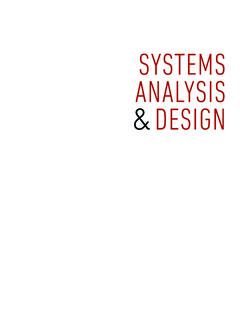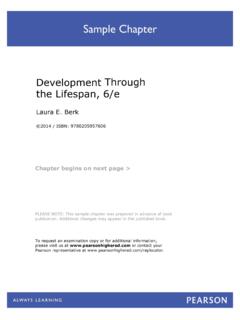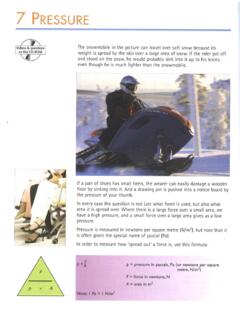Transcription of Water Pressure and Pressure Forces - Pearson
1 7/3/09 7:03 PM Page 14. 2. Water Pressure and Pressure Forces The Free Surface of Water When Water fills a containing vessel, it automatically seeks a horizontal surface on which the Pressure is constant everywhere. In practice, a free Water surface is one that is not in contact with an overlying vessel cover. A free Water surface may be subjected to atmospheric Pressure (open vessel) or any other Pressure that is exerted within the vessel (closed vessel). Absolute and Gauge Pressures A Water surface in contact with the earth's atmosphere is subjected to atmospheric Pressure , which is approximately equal to a column of Water at sea level. In still Water , any object located below the Water surface is subjected to a Pressure greater than atmospheric Pressure . This additional Pressure is often referred to as hydrostatic Pressure . More precisely, it is the force per unit area acting in a normal direction on the surface of a body immersed in the fluid (in this case Water ).
2 To determine the variation of hydrostatic Pressure between any two points in Water (with a specific weight of ), we may consider two arbitrary points A and B along an arbitrary x-axis, as shown in Figure Consider that these points lie in the ends of a small prism of Water having a cross-sectional area dA and a length L. PA and PB are the pressures at each 14. 7/3/09 7:03 PM Page 15. Sec. Absolute and Gauge Pressures 15. x PA. A. L. h = L sin . y . B. PB. Figure Hydrostatic Pressure on a prism end, where the cross-sectional areas are normal to the x-axis. Because the prism is at rest, all Forces acting on it must be in equilibrium in all directions. For the force components in the x-direction, we may write Fx = PA dA - PB dA + LdA sin u = 0. Note that L # sin u = h is the vertical elevation difference between the two points. The above equation reduces to PB - PA = h ( ).
3 Therefore, the difference in Pressure between any two points in still Water is always equal to the product of the specific weight of Water and the difference in elevation between the two points. If the two points are on the same elevation, h = 0 and PA = PB. In other words, for Water at rest, the Pressure at all points in a horizontal plane is the same. If the Water body has a free surface that is exposed to atmospheric Pressure , Patm, we may position point A on the free surface and write 1PB2abs = h + PA = h + Patm ( ). This Pressure , 1PB2abs, is commonly referred to as the absolute Pressure . Pressure gauges are usually designed to measure pressures above or below the atmospheric Pressure . Pressure so measured, using atmospheric Pressure as a base, is called gauge Pressure , P. Absolute Pressure is always equal to gauge Pressure plus atmospheric Pressure : P = Pabs - Patm ( ).
4 Figure diagrammatically shows the relationship between the absolute and gauge pres- sure and two typical Pressure -gauge dials. Comparing Equations and , we have P = h ( ). 7/3/09 7:03 PM Page 16. 16 Water Pressure and Pressure Forces Chap. 2. solute Pressure Ab 20. 30. 10 10. 20. 0 ge pres Gau sure 40. 30. 0 Meters H2O 40. 70 50. 50. Absolute Pressure ( Water column, m). 80 60. 60. 70. +P1. Atmospheric Pressure solute Pressure Ab 20. P2 30. 10 10. 20. 0 press u ge ure 40. Ga 30. 0 +(P1)abs Meters H2O 40. 70 50. +(P2)abs 60 50. 80. 60. 70. Absolute vacuum 0. Figure Absolute and gauge Pressure or P. h = ( ). g Here the Pressure is expressed in terms of the height of a Water column h. In hydraulics it is known as the Pressure head. Equation may thus be rewritten in a more general form as PB PA. - = h ( ). g g meaning that the difference in Pressure heads at two points in Water at rest is always equal to the difference in elevation between the two points.
5 From this relationship we can also see that any change in Pressure at point B would cause an equal change at point A, because the difference in Pressure head between the two points must remain the same value h. In other words, a Pressure applied at any point in a liquid at rest is transmitted equally and undiminished in all directions to every other point in the liquid. This principle, also know as Pascal's law, has been made use of in the hydraulic jacks that lift heavy weights by applying relatively small Forces . 7/3/09 7:03 PM Page 17. Sec. Surfaces of Equal Pressure 17. Example The diameters of cylindrical pistons A and B are 3 cm and 20 cm, respectively. The faces of the pistons are at the same elevation, and the intervening passages are filled with an incompressible hydraulic oil. A force P of 100 N is applied at the end of the lever, as shown in Figure What weight W can the hydraulic jack support?
6 P. 80 cm 20 cm W. A B. 3 cm 20 cm F. Measurements in cm Figure Hydraulic jack Solution Balancing the moments produced by P and F around the pin connection yields 1100 N21100 cm2 = F120 cm2. Thus, F = 500 N. From Pascal's law, the Pressure PA applied at A is the same as that of PB applied at B. Therefore, F W. PA = PB =. 31p # 3 2 2>44 cm2 31p # 20 2 2>44 cm2. 500 N W. =. cm2 314 cm2. 314 cm2. W = 500 N = * 10 4 N. cm2. Surfaces of Equal Pressure The hydrostatic Pressure in a body of Water varies with the vertical distance measured from the free Water surface. In general, all points on a horizontal surface in a static body of Water are subjected to the same hydrostatic Pressure , according to Equation For example, in Figure (a), points 1, 2, 3, and 4 have equal Pressure , and the horizontal surface that contains these four points is a surface of equal Pressure .
7 However, in Figure (b), points 5 and 6 are on the same horizontal plane but the pressures are not equal. This is because the Water in the two tanks is not connected and the overlying depths to the free surfaces are different. Applying Equation would produce different pressures. Figure (c) displays tanks filled with two immiscible liquids of different densities. (Note: Immiscible liquids do not readily mix under normal condi- tions.) The horizontal surface (7, 8) that passes through the interface of the two liquids is an 7/3/09 7:03 PM Page 18. 18 Water Pressure and Pressure Forces Chap. 2. ES = equal Pressure surface NES = nonequal Pressure surface Oil NES NES. 5 6. ES 9 10. 1 2 3 4 8. ES. 7. H2O. Valve closed (a) (b) (c). Figure Hydraulic Pressure in vessels equal Pressure surface. Applying Equation at both points leads to the same Pressure ; we have the same fluid ( Water ) at both locations (just below the interface at point 8), and both points are the same distance beneath the free Water surface.
8 However, points 9 and 10 are not on an equal Pressure surface because they reside in different liquids. Verification would come from the application of Equation using the different depths from the free surface to points 9 and 10 and the different specific weights of the fluids. In summary, a surface of equal Pressure requires that (1) the points on the surface be in the same liquid, (2) the points be at the same elevation ( , reside on a horizontal surface), and (3) the liquid containing the points be connected. The concept of equal Pressure surface is a use- ful method in analyzing the strength or intensity of the hydrostatic Pressure at various points in a container, as demonstrated in the following section. manometers A manometer is a Pressure -measurement device. It usually is a tube bent in the form of a U that contains a fluid of known specific gravity.
9 The difference in elevations of the liquid surfaces under Pressure indicates the difference in Pressure at the two ends. Basically, there are two types of manometers : 1. An open manometer has one end open to atmospheric Pressure and is capable of measuring the gauge Pressure in a vessel. 2. A differential manometer has each end connected to a different Pressure tap and is capable of measuring the Pressure difference between the two taps. The liquid used in a manometer is usually heavier than the fluids to be measured. It must form a distinct interface that is, it must not mix with the adjacent liquids ( , immiscible liquids). The most frequently used manometer liquids are mercury 1sp. gr. = , Water 1sp. gr. = , alcohol 1sp. gr. = , and other commercial manometer oils of various specific gravities ( , from Meriam* Red Oil, sp. gr. = to Meriam No.)
10 3 Fluid, sp. gr. = ). * Meriam Process Technologies, Cleveland, Ohio 44102. 7/3/09 7:03 PM Page 19. Sec. manometers 19. Water A Water B. Atmosphere Water A. y D. y h h C. 1 2 1 2 Liquid M. Liquid M. (a) (b). Figure Types of manometers : (a) open manometer and (b) differential manometer Figure (a) shows a schematic of a typical open manometer; Figure (b) shows a schematic of a typical differential manometer. It is obvious that the higher the Pressure in vessel A, the larger the difference, h, in the surface elevations in the two legs of the manometer. A mathematical calculation of Pressure in A, however, involves the densities of the fluids and the geometry involved in the entire measuring system. A simple step-by-step procedure is suggested for Pressure computation. Step 1. Make a sketch of the manometer system, similar to that in Figure , and approx- imately to scale.


















